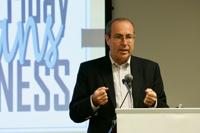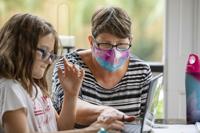The COVID-19 pandemic has dealt South Carolina an economic crisis like no other, with a relatively small segment of workers and businesses suffering the greatest losses, while much of the state has weathered the stay-at-home orders and social distancing with little or no lasting financial impact.
Shaniqua McCants has seen the worst of that economic division.
After losing her job as a dispatcher for a North Charleston trucking firm and a side gig as a wedding singer, McCants landed a server position — at about half her previous pay — with James Island restaurant Maple Street Biscuit Co. She has since been promoted to assistant manager and her salary now is close to what she had been making, but the virus definitely threw her for a loop.
By contrast, Ford Simmons and wife Rachel barely skipped a beat when the pandemic hit.
“We were fortunate that we both were able to keep our full-time jobs and work from home,” said Ford Simmons, a grants administrator at the Medical University of South Carolina. Rachel Simmons works with a women’s scholars initiative at the hospital. Their biggest hitch was a loan on the home they built on James Island that took a little longer than normal to close. Ford Simmons said the couple used the extra time to store away some cash since there wasn’t anything to do or anywhere to go.
“We spent it on new stuff for the house,” he said.
That kind of economic dichotomy isn’t likely to change a great deal in the coming months, despite promising news from drugmakers that say their coronavirus vaccines are showing 90 percent or better effectiveness against the disease. Those shots could be available in limited quantities by the end of this year, although inoculating hundreds of millions of Americans will be a process that stretches well into 2021.
“One thing we need to emphasize is that until we get a vaccine or widespread treatment, we’re not going to see a full recovery,” Joey Von Nessen, a research economist at the University of South Carolina, told the state Board of Economic Advisors in October.
Even after widespread vaccinations have occurred, the lifestyle and technological changes that have taken place during months of being homebound — Zoom meetings, online shopping, telemedicine and a reluctance toward air travel, restaurant dining and large-group gatherings — aren’t going away anytime soon.
“The virus crisis forced people to do things differently,” said Russell Sobel, professor of economics and entrepreneurship at The Citadel. “As a result of these changes, some people will have discovered options and developed skills that will cause them to make different choices in the future.”
That means more pain for the state’s tourism, recreation and food-service industries, which have seen as many as one out of every five jobs eliminated since February, according to a study by the University of New Hampshire. Those losses in traditionally low-wage sectors have come despite a commitment of more than $6 trillion in monetary and fiscal stimulus from the federal government, such as forgivable loans to keep workers on the payroll.
Meanwhile, many higher-wage occupations have maintained their employment levels or even expanded during the crisis.
The wage factor
The state’s manufacturing industry, a major source of paychecks in the Upstate and Lowcountry, lost just 0.2 percent of its jobs through October, according to the University of New Hampshire study. South Carolina’s construction, real estate and logistics industries added workers during that period.
While it’s difficult to separate the heartache of millions of COVID-19 infections and hundreds of thousands of deaths from the impersonal economic statistics generated in the virus’ wake, the numbers show a clear separation between the pandemic’s haves and have-nots.
Employment of middle-income workers making between $27,000 and $60,000 a year has fallen 3.2 percent in South Carolina since January, according to Opportunity Insights’ trackthereccovery.org website. Nationally, employment in that wage group is down 4.7 percent. By comparison, low-income employment — workers making less than $27,000 a year — has fallen 16 percent in South Carolina and 19.2 percent nationally.
Jobs paying more than $60,000 a year have actually grown — by 0.5 percent in South Carolina and 0.2 percent nationally.
The trend is similar in Charleston County, where the number of jobs paying more than $60,000 per year has increased by 4.8 percent during the pandemic while middle-income and low-wage jobs have fallen. At its April 15 low point, more than 40 percent of workers in the county making less than $27,000 a year had lost their jobs. Employment at the high end never fell more than 14.3 percent.
“This is a situation that’s hitting different demographics in different ways,” said Laura Ullrich, an economist with the Federal Reserve Bank in Richmond, Va.
McCants, the former dispatcher-turned-restaurant worker, said she sold used clothing and home furnishings online during the months when she was unemployed.
“That pretty much kept me on my feet during those times when I didn’t have a job,” she said, adding that for two months she would wake up every day, log on to her computer and fill out applications for any type of job. Maple Street Biscuit Co. reached out to her within two hours after she applied.
“They hired me on the spot,” McCants said.
Hers is one of the industry’s few success stories.
A total of 43,000 leisure and hospitality industry workers in South Carolina lost their jobs in the year leading up to Oct. 31, according to the state Department of Employment and Workforce. While that’s a large number, it’s just 2 percent of the state’s nonfarm workforce. And the money those jobs pay — an average of about $22,600 a year, according to the U.S. Bureau of Labor Statistics — is among the state’s lowest, blunting the economic impact of their disappearance.
“In the grand scheme of how many people work in South Carolina, it really is not that big,” Frank Hefner, an economist at the College of Charleston, told state economic leaders. “Except for hospitality, tourism and restaurants, other areas are doing OK.”
A growing debt bomb
Mark Witte, who teaches economics at the College of Charleston School of Business, said one key reason the downturn of 2020 is so haphazard is that it was triggered by a fast-moving and unpredictable health crisis rather than a sudden collapse within the financial system that normally would lead to widespread damage, such as the subprime lending debacle from more than a decade ago. That has helped widen the gap between the winners and losers.
“It not at all like the 2008 and 2009 recession,” Witte said.
The impact on business segments is perhaps best reflected in consumer spending. It has increased 2.3 percent overall in South Carolina during the pandemic, but has fallen by 10.7 percent for hotels and restaurants and a whopping 53.3 percent for recreation and attractions. The total for the dining industry likely would be worse if not for the sudden shift to takeout orders and home deliveries.
Grocery stores and retailers, segments where pickup and delivery services have allowed consumers to shop with little or no human interaction, saw an increase in spending of 15.1 percent and 14.2 percent, respectively, statewide.
People have learned to avoid groups and make do at home. South Carolinians are spending 18.9 percent less time in the office now than when the pandemic started. When people do go outside, they go to places like parks, where interaction with others can be limited. All told, they are spending 6 percent less time outside of their homes than they were in January.
The economic hit from the COVID-19 crisis has been uneven, and some economists warn the government’s reaction to the virus has created a ticking time bomb that will eventually affect everyone.
“I think that in the long term we’re going to see some significant changes in the economy, and some fairly substantial negative secondary effects of our recent government policies,” said Sobel, the Citadel professor.
An increasing federal debt — roughly $27.3 trillion — that’s been exacerbated by stimulus measures funded by more borrowing will likely weigh on growth for years to come. By 2022, the federal debt is expected to top a record 140 percent of gross domestic product. That means the government will owe nearly 1.5 times the amount of all annual economic production nationwide.
“Currently, interest rates are low, but as they rise, the interest costs of servicing this debt will become substantial,” Sobel said. “This will require cuts to other areas of spending, higher taxes and a larger burden on the government sector. Economic growth will be slower in the future as a result of the consequences of this debt.”
And, like many consumers caught in a credit card spending binge, the federal government rarely learns from its financial mistakes.
“Economists have long noted that when the government responds to a crisis, the higher regulations and spending that occur never fully disappear even once the crisis is over,” Sobel said. “So we can expect a permanently larger degree of government intervention in our activities, as well as in our economic lives.”
In short, America will recover from the coronavirus pandemic, but getting back to “normal” will take a very long time — if it occurs at all.






